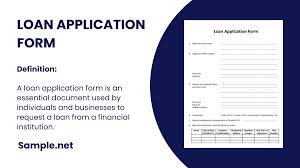Loan application forms play a vital role in the lending process. They are widely used by banks, credit unions, online lenders, and even peer-to-peer platforms to gather comprehensive information from individuals or businesses applying for a loan.
These forms typically collect details such as personal and contact information, employment and income data, the amount requested, the loan’s purpose, collateral (if applicable), and authorization for credit checks.
By standardizing the way data is collected, these forms simplify the evaluation process, helping lenders assess eligibility, manage risk, and make better-informed decisions. Loan application forms are utilized in various types of loans, including personal, business, mortgage, auto, student, and micro-loans.
With Jotform, creating and managing online loan application forms becomes easy and efficient—even for users with no coding skills. The platform offers a user-friendly drag-and-drop Form Builder that allows you to add custom fields, connect to payment systems, and use conditional logic to tailor each form to your specific lending process.
All submissions are automatically captured and organized in Jotform Tables, providing a centralized location to review, manage, and collaborate with your team. Whether you’re a small lender or a large financial institution, Jotform helps you streamline application workflows, increase accuracy, and deliver a better experience to borrowers.
Common Use Cases for Loan Application Forms
Loan application forms are extremely versatile and can be customized to suit a wide range of financial and organizational needs. Here are several scenarios where they are commonly used:
Popular Use Cases:
- Personal loan forms for individuals seeking funds for emergencies, travel, or debt consolidation
- Business loan forms for new startups or expanding enterprises
- Mortgage applications for purchasing homes or real estate
- Auto loan applications for financing new or used vehicles
- Student loan forms to help pay for college or vocational training
- Micro-loan applications for small businesses or community-based lending
Problem-Solving Benefits:
- Ensures consistent data collection and reduces user errors
- Speeds up pre-qualification and eligibility assessment
- Supports compliance by capturing disclosures and applicant consent
- Streamlines the internal review, approval, and funding process
Typical Users:
- Traditional banks and online lenders
- Real estate agencies and mortgage brokers
- Auto dealerships and vehicle finance companies
- Universities and financial aid offices
- Nonprofits, NGOs, and microfinance institutions
Form Design Differences by Loan Type:
- Personal loan forms emphasize credit history, income, and employment
- Business loan forms require business plans, tax returns, and revenue reports
- Mortgage forms collect property details, down payments, and co-applicant info
- Auto loan forms may include dealership and vehicle data
- Student loan forms request school enrollment and academic background
Loan application forms are highly adaptable and can be tailored to any type of lending situation, ensuring that the right information is collected based on the applicant’s needs and loan type.
How to Build an Effective Loan Application Form Using Jotform
Creating a professional loan application form with Jotform is simple and customizable. Here’s a step-by-step guide to help you get started:
1. Choose a Template or Start from Scratch Log in to your Jotform account and click “Create.” Select “Form” to begin. You can pick from a wide range of pre-designed loan application templates or start with a blank form. Decide between a Classic Form (all questions on one page) or a Card Form (one question per page), depending on your audience’s comfort.
2. Add Essential Fields Use Jotform’s drag-and-drop builder to include all necessary input fields, such as:
- Full name, email, phone number, and physical address
- Employment status, employer name, and monthly income
- Requested loan amount and intended use of the funds
- Collateral information (if it’s a secured loan)
- Checkboxes for applicant consent and credit check authorization
- Upload fields for documents like pay stubs, business plans, or tax returns
For specific loan types:
- Business loans should include company name, tax ID, and financial statements
- Mortgage or car loans should have sections for property or vehicle details
3. Personalize the Form Appearance Click the “Form Designer” (paint roller icon) to match the form’s appearance with your brand. You can change fonts, background colors, and add your logo. Customize the form link for a polished, professional look.
4. Add Logic and Integrations Use conditional logic to simplify the user experience—for example, display additional fields only when the loan type requires it. Integrate the form with your CRM, accounting software, or payment gateway if needed. This enables automation of the intake process.
5. Set Up Notifications Create automatic email alerts for your team so they are notified each time a form is submitted. You can also send confirmation emails to applicants with a copy of their application and next steps.
6. Publish and Share Click “Publish” to get the shareable link. You can send this via email, add it to your website, or post it on social platforms. You can also embed the form directly on your website for easy access.
7. Test and Monitor Before going live, use the Preview function to test all fields, conditional logic, and integrations. Once active, monitor applications using Jotform Tables to sort, filter, and review submissions. This feature also allows team members to collaborate efficiently.
By following these steps, you can build a custom loan application form that collects complete, accurate information while making the process smoother for both your team and applicants. Whether for personal lending or complex business finance, Jotform’s tools ensure your system is professional, secure, and efficient.
Join Gen Z New WhatsApp Channel To Stay Updated On time https://whatsapp.com/channel/0029VaWT5gSGufImU8R0DO30


